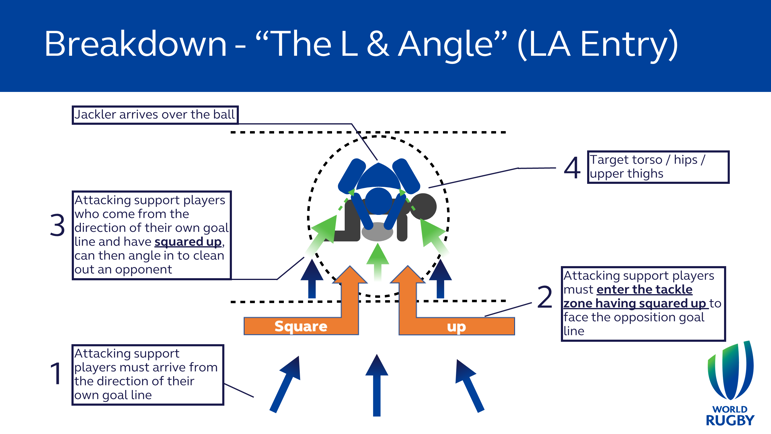Breakdown Laws - Dos and Don'ts
In March 2020, referees were issued with guidelines on enforcement of current law – refereeing at the breakdown. There was no need for new laws or law change, rather a re-focus on existing law. The following points are a summary:
Tackler
LAW 14: Tackle
5. Tacklers must:
a. Immediately release the ball and the ball-carrier after both players go to ground.
b. Immediately move away from the tackled player and from the ball or get up.
- Tackler must release
- Once the tackle is complete, the tackler may contest possession, providing that the player is on their feet, has shown a clear release of the ball and tackled player and arrives from the direction of their own goal line
- Tackler must roll away
Ball Player
LAW 14: Tackle
2. Being brought to ground means that the ball-carrier is lying, sitting or has at least one knee on the ground or on another player who is on the ground.
5. Tacklers must:
d. Allow the tackled player to release or play the ball.
- Ball player must place or play the ball immediately – the ball player should not be allowed time for a second movement such as rolling, crawling, bouncing etc.
- When the ball-carrier’s knee touches the ground, the tackler must release immediately.
First arriving player
LAW 15: Ruck
11. Once a ruck has formed, no player may handle the ball unless they were able to get their hands on the ball before the ruck formed and stay on their feet.
12. Players must endeavour to remain on their feet throughout the ruck.
- A “jackler” is a player who wins possession of the ball before a ruck forms.
- Reward the player who wins the race for possession.
- Remove the concept of the jackler “surviving the clear out” by opposition players.
- The jackler must be in a strong position to try and lift, with hands on the ball.
- The jackler must support their body weight throughout – no going to ground and then resetting.
Other arriving players
LAW 15: Ruck
5. An arriving player must be on their feet and join from behind their offside line.
6. A player may join alongside but not in front of the hindmost player.
10. Possession may be won either by rucking or by pushing the opposing team off the ball.
- Enforce the tackle gate and penalise side entries into the ruck.
- Encourage arriving players to drive and bind to opponents rather than diving in or tackling them.
Putting the laws into practice
As a result of these guidelines, coaches and players should endeavour to demonstrate to the referee that their actions in the breakdown are accurate and legal. The following simple points should assist:
Tackler
Tackle or no tackle
- For a tackle to occur, the Ball Player is held and brought to ground by one or more opponents.
- Being brought to ground means that the Ball Player is lying, sitting or has at least one knee on the ground or on another player who is on the ground.
- Being held means that a Tackler must continue holding the Ball Player until the Ball Player is on the ground.
- If the Ball Player is not held and brought to ground then there is no tackle, and the Ball Player can get straight back up without letting go of the ball.
Tackle release – Tacklers must:
- Immediately release the ball and the Ball Player after both players go to ground.
- Immediately move away from the tackled player and from the ball or get up.
- Be on their feet before attempting to play the ball.
- Allow the tackled player to release or play the ball.
- Allow the tackled player to move away from the ball.
Legal exit from tackle contest
- tackler must roll east/west immediately and not impede play
Get back onside
- tackler should return to an onside position immediately
Ball Player
Presentation
- On making contact with the ground, the Ball Player should show a dynamic ball presentation movement.
Movement on the ground
- Ball Player can roll with momentum but not stop, then re-roll, or elbow crawl to buy time for support or to gain additional forward movement once their momentum has stopped.
First arriving player
The Jackler:
- must be on their feet and join from behind the offside line
- if also the tackler, then they must show clear release of the Ball Player
- must support their own body weight throughout – no going to ground and then resetting
- must target the ball and lift it legally
- must target the ball directly when the Ball Player falls on top of the ball (clamp technique)
- if deciding not to contest, must counter ruck in a legal manner.
Other arriving players
Support Players:
- must enter legally
- angle of entry - alongside and not in front of the hindmost player (square up / L-in)
- on their feet and joining from behind their offside line

- must be accurate in their clean out, binding to opponents and driving rather than diving in or tackling them (Drive not dive)
- if trying to remove the jackler, must clean out legally, by levering the player out of the contest. It is illegal to target or drop-weight onto the lower limbs
- if latching onto the ball-carrier, the player must observe all the requirements for a first arriving player, particularly the need to stay on their feet.